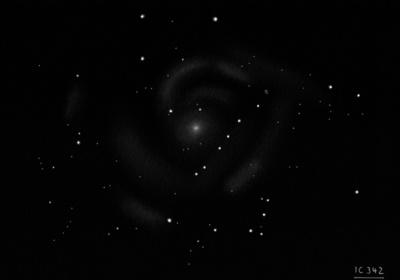
E.E. Barnard discovered IC 342 on 11 Aug 1890 with the 12-inch refractor at Lick Observatory. He sketched it at 150x as well as 500x and noted, "with 500x it is quite a bright object, 1/2' dia and quite [?], mbM, not cometary. Object 1' S of this star [shown on sketch] and following 3 or 4 seconds." His rough position and sketch (showing the superimposed linear strings of stars) is an excellent match.
William Denning independently discovered IC 342 on 19 Aug 1892 while comet hunting with his 10-inch reflector. The discovery was announced in a short note, "New nebula", Astronomy and Astro-Physics, 12, 189 (1893). He called it "rather faint, with nucleus about 12th magnitude, and very small, but it was sufficiently conspicuous to be discovered with a power of 40 only on my 10-inch reflector." As Barnard never published his discovery or informed Dreyer, Denning was credited with the discovery in the IC.
In a note by Hubble and Seyfert titled "A Spiral Nebula of Unusually Large Dimensions" (Harvard College Observatory Bulletin No. 899, pp.16-17): "In a letter written to Dr. J. L. Dreyer before 1894, Mr. W. F. Denning, the well known meteor observer of Bristol, included in a short list of new nebulae an object in the position 3h 37m 8s, +67d 46.9' (1900), which was simply described as "pretty bright, very small, star of 12th magnitude close to nucleus."
Hubble and Humason (1934), first recognized this object as a spiral galaxy and suggested it was possibly a Local Group member (heavily reddened) based on its recessional velocity, though it was later shown to be too distant. IC 342 is one of the brightest members of the IC 342/Maffei Group that includes NGC 1560, NGC 1569 and highly obscured Maffei I and 2.
200/250mm - 8" (3/21/20): the small core/nucleus was very noticeable, as well as a very large, roundish outer halo ~15' diameter with a diaphanous appearance. The halo seemed to fill in the gaps between the numerous surrounding stars.
8" (10/13/81): very faint, large, very diffuse outer halo, very small prominent 12th magnitude nucleus. A line of three stars is superimposed.
300/350mm - 13.1" (1/18/85): at 144x the nucleus is prominent as a mag 12 "fuzzy" star. At this power the outer halo disappears.
400/500mm - 17.5" (12/16/95): very unusual galaxy, appears as a very faint, very large glow surrounding a 1' high surface brightness core that increases to a bright stellar nucleus. The irregular halo is difficult to trace but extends to ~10' diameter with a number of superimposed stars including a striking 6' string of six mag 10.5-12.5 stars oriented NW-SE on the southwest side of the halo. No arm structure was seen. The core forms a small triangle with two similar superimposed mag 11 stars 1.0' N and 2.0' NE. Situated just 10.6° above the galactic plane and suffers from significant dust obscuration.
600/800mm - 24" (3/21/20): at 124x and 200x; this obscured galaxy contained a very bright 30" nucleus that gradually increased to a sharp stellar point. The nucleus was surrounded by a fairly faint core/central region with a diameter of at least 1'. A 12th mag star is just 1' N of the nucleus. This star is the middle of 3 nearly in a line with a mag 12 star 2' E and a mag 11 star 2.5' WSW. A very diffuse halo of low but irregular surface brightness extends ~15', best viewed at 124x. A distinctive string of 6 stars oriented NW-SE cuts across the halo to the southwest of the nucleus. Spiral arm structure was very subtle and only seen in patches or sections, one on the north side, roughly 5' from the core.
UGC 2826, located 21' NW, appeared fairly faint, elongated 3:2 NW-SE, ~0.6'x0.4', low but uneven surface brightness, weak concentration.
Notes by Steve Gottlieb